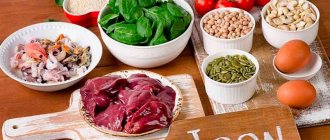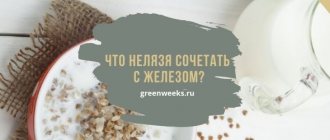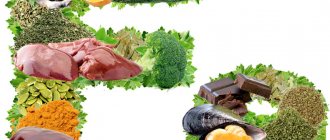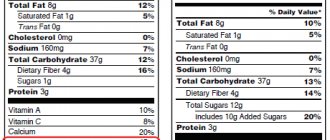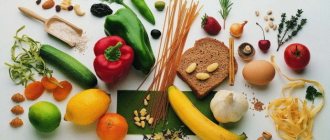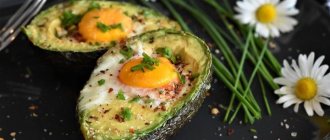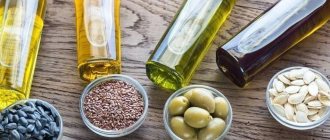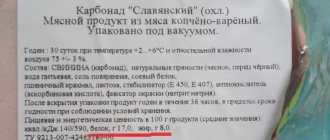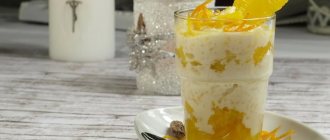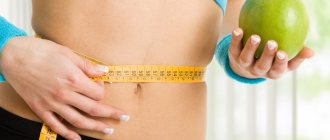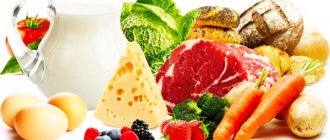Excess weight is not always associated with a predominantly sedentary lifestyle and banal overeating. There are many girls who go to the gym and stick to a diet, but cannot lose weight. The reason for this is often a deficiency of iron, a microelement that has a direct effect on metabolism and thyroid function. If such a problem occurs, the efforts made not only do not produce any results, but, on the contrary, lead to an even greater gain of extra pounds.
Iron is an essential trace element responsible for many important functions for the human body. Its excess and deficiency negatively affect health and well-being. Both conditions are deviations from the norm, but most often people suffer from a deficiency of this microelement.
How much iron does a person need per day?
The amount of iron you need from food each day depends on your age and gender, and whether you eat animal foods. Average daily iron intakes are listed below and are expressed in milligrams (mg). Vegetarians who do not eat meat or seafood need almost twice as much iron as indicated in the table, since the human body absorbs “non-heme” iron from plant foods less well than it absorbs “heme” iron from animal foods (source 1).
| Gender/age | mg iron per day |
| For babies 0-6 months | 0,27 |
| For babies 7-12 months | 11 |
| For children 1-3 years old | 7 |
| For children 9-13 years old | 8 |
| For men 14-18 years old | 11 |
| For men 19 and older | 8 |
| For women 14-18 years old | 15 |
| For women 19-50 years old (before menopause) | 18 |
| For women over 50 years of age (postmenopausal) | 8 |
| For pregnant | 27 |
| For breastfeeding women (in the absence of menstruation) | 9 |
General recommendations for men of all age groups and post-menopausal women are 8 mg iron per day, and for menstruating women 18 mg/day. The tolerable upper limit of iron intake for adults is 45 mg per day. If this level is exceeded, gastrointestinal upset may occur (source2).
Laboratory check: not just hemoglobin!
The hemoglobin level, of course, is a very important indicator, but it must be remembered that its norm does not exclude the presence of the latent (hidden) iron deficiency we have already mentioned - a condition in which the metal reserves in the body are already depleted. That is why today, for a more accurate diagnosis of an iron deficiency state, in addition to hemoglobin and the number of red blood cells, a whole range of laboratory indicators is used: ferritin and serum iron levels, iron-binding capacity of serum, transferrin saturation with iron, morphological assessment of red blood cells, etc. A full check will help the specialist dot the i's. . If there is a severe lack of iron and anemia, it is necessary to conduct an urgent comprehensive examination to identify possible health problems that are causing it.
Readily Available Iron 18 mg, 60 Capsules, Nature's Bounty
925 ₽
Dietary supplement NOT A MEDICINE
The dangers of iron deficiency and lack of iron-containing foods in the diet
Above we talked about what role iron plays in the body and how much a person needs per day. Before we get into the iron-rich foods tables, we need to say a few more words about iron deficiency, the most common nutritional deficiency in the world.
When the body's iron consumption is not compensated by adequate dietary iron intake, latent iron deficiency occurs (first, low ferritin, then decreased iron levels in serum and carrier proteins), which eventually develops into iron deficiency anemia. With anemia, there is no longer enough red blood cells and hemoglobin in a person’s blood. The main symptoms of this condition are fatigue, weakness and irritability. If anemia is not treated promptly, a person may experience a fast or irregular heartbeat, shortness of breath, dizziness, deterioration of the skin, hair, and nails, complications during pregnancy, and slow growth in infants and children (sources, ).
Fortunately, unless your anemia is caused by frequent blood loss or problems with the body's absorption of iron, you can overcome iron deficiency by including foods high in iron in your diet. And this is not the notorious pomegranate, which contains only 0.3 mg of iron per 100 g of product, and not even such quickly oxidizing foods as avocados (0.55 mg/100 g), bananas (0.26 mg/100 g) and apples (0.12 mg/100 g).
Why does our body need iron?
Iron has a fairly important function in the human body, and its deficiency leads people to serious ailments. This condition can occur in people who diet, drink excessive amounts of alcohol, or smoke excessively.
Iron is a very important component responsible for the amount of hemoglobin in the blood, and in combination with many other enzymes is responsible for proper metabolism.
It directs oxygen to all cells and organs, helps maintain immunity in the body, plays a role in energy metabolism, helps increase nerve fibers, and is also a necessary component for pregnant women, because if there is insufficient quantity of it while expecting a child, a woman can get serious complications.
TOP 18 foods containing large amounts of iron:
This list includes the animal and plant foods with the highest iron content per 100g, without taking into account the absorption of iron from different sources. According to Vegetarian Journal, vegans are recommended to eat about 1.8 times more iron from plant sources than non-vegetarians.
- Shellfish: from 7 to 14 mg of iron per 100 g of finished product;
- Liver, kidneys, heart: from 7 to 18 mg/100 g, stewed or fried;
- Legumes: from 2 mg for peas, to 15 mg for soybeans;
- Dark chocolate: 6-12 mg iron/100 g;
- Caviar: 11-12 mg;
- Seeds: from 5.7 mg for flax to 14.5 mg for sesame;
- Cashew nuts: 6-6.7 mg iron;
- olives , canned: 6.3 mg;
- Meat and poultry: 0.5-5 mg (2.5-5 mg for beef, 3-4.5 mg for ducks, geese, quail);
- Greens and cabbage: 1 mg (romaine lettuce) to 17.5 mg (thyme);
- Dried fruits: from 1 to 7 mg (2.6 mg of iron in 100 g of dried apricots, 3.5 mg in prunes);
- Quail eggs: 3.7 mg;
- Bran and cereals , especially amaranth, quinoa, bulgur: from 1 mg (boiled bulgur) to 18 mg (rice bran);
- Algae: 2-8 mg in raw form, 28.5 mg in dried spirulina;
- Fish: 1-2 mg baked, fried or grilled;
- Goat cheese: 1.6-1.9 mg;
- Onions and garlic: 1-2 mg;
- Mushrooms: from 1 mg (honey mushrooms, oyster mushrooms) to 12 (morels).
Source of figures: food composition databases. Detailed tables for all product categories are provided below in this article.
The expert does not recommend
It is believed that residents of large cities are not at risk of anemia, since a large amount of dissolved iron is present in tap water. The body absorbs it from untreated water, so you should drink it unboiled. According to Nika Tyutyunnikova, doing this is dangerous. Untreated tap water contains impurities that are hazardous to health. Before drinking, water must be filtered, and it is better to use purified bottled water.
Also an expert on the portal “Hurray! Cooks” recommends abandoning “folk” methods of fortifying food with iron.
- Ironing of food with dishes. Cooking in cast iron does not increase the iron content of foods. Metal in any form is not absorbed by the body. The body is able to accept iron in the form of lactate, sulfate, chloride, and complexes of salts with ascorbic and folic acids.
- Eating acidic foods at breakfast. Acidic, fermented foods actually increase the bioavailability of iron. But starting breakfast with orange juice or sauerkraut is a mistake. The abundance of acids will cause excess production of gastric juice, increasing its acidity. Over time, such a diet will lead to gastritis. Acidic foods should not be consumed on an empty stomach.
The mineral is bound by calcium and tannins. The first is found in dairy products; tea and coffee are rich in tannin compounds. Do not drink foods that contain iron and increase hemoglobin with milk. Drink tea two hours after meals, giving your body time to absorb the iron.
Difference in iron from animal and plant foods
The best food sources of iron contain “heme” iron, which is easier to absorb and virtually uninhibited by medications or other dietary components. Heme iron comes from hemoglobin and, accordingly, is found in foods that originally contained hemoglobin: meat, fish and poultry. Additionally, some studies have shown that iron is better absorbed when it chelates (interacts) with amino acids (source). And from our article What foods contain protein, you could find out that meat, fish and poultry are the highest quality sources of amino acids.
Non-heme iron is found in large quantities in both meat and plant foods such as soybeans, lentils, cabbage, leafy vegetables, cashews, seeds, mushrooms and dried fruits. However, some of them may also contain substances that interfere with the absorption of iron, for example, polyphenols, oxalates and phytic acid. Legumes and dark green leafy vegetables (including broccoli, kale and some leafy greens) are considered good sources of iron for vegans. In contrast, spinach and chard are high in oxalates, which bind iron and make it virtually unavailable for absorption.
More than 85% of the iron in the average human diet is non-heme, but less than 20% of this iron is absorbed into the body. For this reason, it is recommended to combine plant sources of iron in one meal with vitamin C, which helps the body absorb iron. Examples of such combinations: bean salad with bell pepper, spinach with lemon juice, sun-dried tomatoes with herbs. Sources: , , , .
Does calcium affect iron absorption?
A number of studies have shown that calcium can inhibit iron absorption. This point is often a concern because calcium is an important part of the diet of children and pregnant women, who are already at risk of iron deficiency. However, the results of most human studies have shown that Ca has only a minor effect on iron absorption unless Ca intake is typically very low. Sources: , .
Read the blog Forest Fairy: What foods contain calcium
Iron for vegetarians
There are many products for vegetarians, vegans and those who prefer to eat less animal products. The iron contained in these foods is called non-hemoglobin iron.
List of such products:
- Legumes including lentils, chickpeas and beans (
- Tofu and tempeh
- Nuts and seeds
- Leafy green vegetables such as spinach, beet tops, asparagus and broccoli
- Whole grain and iron-fortified breads and cereals
- Dried fruits
These plant sources are less biologically available to the body than hemoglobin (or animal) sources, meaning it is more difficult for your body to absorb this iron.
Luckily, there are some simple ways to improve your body's ability to absorb plant-based iron.
Tables of iron content in animal products
The first table we prepared shows which foods contain the most iron. The highest iron content per 100 g is found in products of animal origin, but not meat, but the spleen, liver, kidneys, hearts and lungs of livestock, as well as poultry offal.
Table 1. Iron content in meat and offal
A few notes:
- Unlisted raw lungs and kidneys contain approximately the same amount of iron as raw liver.
- In unspecified parts of beef there is an average of 2.5 to 3.5 mg of iron per 100 g of product prepared by any method, in lamb - from 1.6 to 2 mg, in veal and turkey - on average 1-1.5 mg, in chicken – 1.4 mg, the least – in pork (0.5-1.5 mg).
- Game meat has a significantly higher iron content than domestic animals and poultry.
- Vegetarian meat substitutes contain on average 12 mg of iron per 100 g of product with a calorie content of 311 kcal.
Also read: What oil to fry in without harm to health
Other animal foods that contain large quantities of iron are shellfish, caviar, algae, fish and crustaceans.
Table 2. Iron content in fish and seafood
Table 3. Other animal foods high in iron
Use during pregnancy
During pregnancy, doctors recommend eating salmon. Moreover, not only because of the high content of omega-3 acids, but also because such fish contains a fairly large amount of folic acid - it is necessary for the production of female sex hormones (with the help of which the pregnancy process and timely ripening of the fetus are controlled ).
Even better in this regard is red salmon caviar, although it is quite expensive.
Omega-3 acids are also known to be beneficial for depression.
Iron content in plant foods
We present to you 7 more tables prepared by us, clearly demonstrating in which plant foods you will find the most iron.
Table 1. Iron content in legumes
Table 2. Iron content in cocoa and chocolate
Table 3. Mushrooms - foods containing large quantities of iron
Note: since mushrooms lose a lot of size after cooking, a 100 g serving of fried or boiled mushrooms will have significantly higher iron content than 100 g of raw mushrooms.
Also read: Which foods contain a lot of vitamin B12?
Table 4. Iron content in vegetables and herbs
Iron content in dried and boiled vegetables (per 100 g of product):
- Sun-dried tomatoes: 9.09 mg iron, 258 kcal;
- Potato peel, baked: 7.04 mg, 198 kcal;
- Spinach, boiled: 3.57 mg, 23 kcal;
- Pumpkin leaves, boiled: 3.20 mg, 21 kcal;
- Chard, boiled: 2.26 mg, 20 kcal;
- Carrots, dried: 3.93 mg, 341 kcal;
- Beet greens, cooked: 1.90 mg, 27 kcal;
- Dandelion greens, boiled; 1.80 mg, 33 Kcal;
- Rapini, boiled: 1.27 mg, 25 kcal;
- Brussels sprouts, boiled: 1.20 mg, 36 kcal;
- Collard greens, boiled: 1.13 mg, 33 kcal;
- Baked potatoes with skin; 1.08 mg, 93 Kcal;
- Red tomatoes, stewed: 1.06 mg, 79 kcal;
- Acorn squash, baked: 0.93 mg, 56 kcal;
- Asparagus, boiled: 0.91 mg, 22 kcal.
Table 5. Iron content in dried fruits, berries and fruits
Also read: The healthiest berries + KBJU, vitamins and minerals in their composition
Table 6. Which grain products are high in iron?
Iron content in some cooked cereals per 100 g:
- Amaranth: 2.10 mg, 102 Kcal;
- Teff: 2.05 mg, 101 Kcal;
- Spelled: 1.67 mg, 127 Kcal;
- Quinoa: 1.49 mg, 120 Kcal;
- Barley: 1.33 mg, 123 Kcal;
- Bulgur: 0.96 mg, 83 kcal.
Also read: The healthiest cereals + tables of their composition
Table 7. Iron content in nuts and seeds
Note: Sesame paste contains 19.20 mg of iron at 586 Kcal, and tahini contains 8.95 mg at 595 Kcal.
"Iron" plan
As always, it is recommended to consult your doctor if you are concerned about anemia. You may also have other conditions that impair absorption and require additional medical attention.
While it may be difficult to meet your iron needs if you don't eat meat or have increased requirements due to pregnancy, it is possible to get enough iron by eating a nutritious diet full of gluten-free fruits, vegetables and grains.
A balanced diet is the key to effectively pumping iron and keeping your body healthy.
Spices are the foods that contain the most iron per 100 g.
Since spices and seasonings are not staple foods and are added to dishes in rather modest quantities, we did not include them in our TOP 18 best sources of iron. However, they are the true record holders for iron content per 100 g. Therefore, at the end of the article, we present to you a list of the TOP 15 spices for iron content:
- Thyme, dried: 123.60 mg;
- Basil, dried: 89.80 mg;
- Mint, dried: 87.47 mg;
- Marjoram, dried: 82.71 mg;
- Jeera (cumin seeds): 66.36 mg;
- Turmeric, ground: 55.00 mg;
- Dill, dried: 48.78 mg;
- Celery seeds: 44.90 mg;
- Bay leaf: 43.00 mg;
- Coriander leaves, dried: 42.46 mg;
- Savory, ground: 37.88 mg;
- Anise seeds: 36.96 mg;
- Oregano, dried: 36.80 mg;
- Fenugreek seeds: 33.53 mg;
- Tarragon, dried: 32.30 mg.
Bomb dish
To ensure your body gets enough iron, eat foods containing it daily. Combine red meat dishes, offal with vegetable salads, cook seafood, omelettes and combine them with legumes, fresh vegetables, and fruits. Iron in foods will benefit the body if you do not combine meat and dairy dishes in one meal.
For dinner, prepare delicious beef with prunes, which will become a favorite dish on your everyday and holiday table.
Beef with prunes
Ingredients for two servings:
- lean beef - 600 g;
- pitted prunes - 150 g;
- onion - 100 g;
- tomato paste - 50 g;
- white wine - 150 ml;
- sunflower oil - 15 ml.
Step by step
- Cut the meat across the grain.
- Fry quickly over high heat. Transfer to a stewing dish.
- Pour wine into the pan where the meat was fried. Bring to a boil, pour over meat.
- Chop the onion, fry in a frying pan, add tomato paste, simmer for two minutes.
- Season the meat with tomato mixture and simmer covered for one hour.
- Add prunes, cut into quarters. Add salt and simmer for another 20 minutes.
